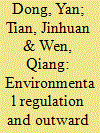| Srl | Item |
| 1 |
ID:
173886


|
|
|
|
|
| Summary/Abstract |
What are the security consequences of population movements? This article seeks to provide a better understanding of when, how, and under what conditions terrorism diffuses across countries via migration flows as a vehicle. We contribute to this debate by studying the influence of migrants’ cultural proximity to the native population of their host country. It is argued that cultural closeness can contain such terrorism diffusion. Similarities in societal norms, customs, or beliefs seem likely to induce trust in the social interactions between migrants and locals. This, in turn, makes it more difficult for terrorist organizations to exploit transnational population movements for radicalization and as a recruitment pool – one of the core mechanisms linking population flows with terrorism. Conversely, migrants from culturally distant societies may find it more challenging to integrate into their new homes. A fertile ground for terrorist organizations for the recruitment of new followers is thereby more likely. Our analyses present consistent evidence that the effect of terrorism diffusing across countries weakens when accounting for cultural closeness between migrants and host societies. This key finding of our research has crucial implications for policy’s and scholars’ understanding of terrorism, the diffusion of terrorism across countries, and the security consequences of population movements.
|
|
|
|
|
|
|
|
|
|
|
|
|
|
|
|
| 2 |
ID:
187919


|
|
|
|
|
| Summary/Abstract |
This paper explores the impact of environmental regulation (ER) on outward foreign direct investment (FDI) flows in China. During the period from 2013 to 2015, all Chinese cities were required to join a nationwide automatic air quality monitoring network in batches, and this policy exogenously raised local environmental regulation. This unique policy implemented full coverage through a staggered adoption, which motivates this paper to apply an event study approach to identify the treatment effect of stringent environmental regulation. Based on a city-year level capital outflows dataset constructed from the fDi Markets database, we obtain three main findings: (1) environmental regulation significantly stimulates outward FDI flows; (2) this promoting effect centers on polluting industries; and (3) these ER-induced FDI outflows are mainly directed toward countries with weaker environmental protection and with a closer geographic and cultural distance to the home country. These results together provide a snapshot confirming the classical “pollution haven hypothesis”.
|
|
|
|
|
|
|
|
|
|
|
|
|
|
|
|